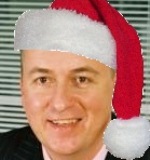 This year, Mott MacDonald found itself in Lapland working with one of the most sought after clients in the consulting world: Santa Claus. Stephen Cavanagh, Divisional Managing Director at Mott MacDonald, spoke to use about his experience working with Santa Claus and his team and the success and difficulties involved in transforming the brand to the 21st Century.
This year, Mott MacDonald found itself in Lapland working with one of the most sought after clients in the consulting world: Santa Claus. Stephen Cavanagh, Divisional Managing Director at Mott MacDonald, spoke to use about his experience working with Santa Claus and his team and the success and difficulties involved in transforming the brand to the 21st Century.
Stephen discusses the challenges of some serious seasonal consulting…
Santa Claus is such a renowned brand – what was it that Mott MacDonald were asked to do?
I think it was a classic case that they weren’t exactly sure what they wanted us to do, but they knew that they had a problem. This is a successful organisation that has been around for hundreds of years, but in the recent times they have seen unprecedented demands and markets change. As a result, years of business practice became no longer fit for purpose, they knew they had a problem and they knew they needed outside help but they weren’t quite sure where and how it was needed.
It must have been intimidating going into a brand with that sort of history and international significance?
It’s a huge brand and from a risk perspective, if you get it wrong 2.2 billion end users (the kids) suffer and as a business you don’t want to be associated with the failure of Santa Claus. It’s a big challenge.
What were the major problems?
Being the head of really the first global brand, Santa was fuelled with arrogance and his notoriety had reinforced his view that he now had a monopoly on the Christmas present market..
That must have created some up front challenges, how did you go about changing the governance model?
There wasn’t a governance model, Santa had adopted a dictatorial style and insisted on making all the decisions: reindeer names, transportation, who was naughty/nice.. Everyone just does what he says and there were no delegated authorities what so ever; the man wouldn’t even trust other people to deliver presents.
We achieved a bit of a breakthrough when we offered Santa some personal coaching. Santa is over 200 years old, and isn’t getting any younger. All those mince pies had sent his BMI through the roof, so he had a stint in fat-camp. While he was there we put in some sessions to think about his life style and how he was running things and he came out with a fresh perspective. We could then help him to plan, implement and deliver a new strategy with tangible business benefits that would reduce his bottom line, as well as his waistline.
Was it difficult to get the staff engaged in this transformation project? How far were their views taken into account?
The elves were a complete nightmare. They had operated in the same way for hundreds of years so from their perspective there was no need for change.
We had to expose them to some of the problems that there were, so we created a burning platform for change, although some stayed on it too long and got their boots charred. But in the end it was the balance between making the elves realise what was really going on out there, as they are quite isolated in Lapland, so getting them better informed. And also introducing the right reward structure – taking best practice from call centres and offering (mulled) wine as a reward for meeting targets. And that did it. They love the stuff.
Lapland really is quite isolated, how well are they adapted to changing technology and ways of working?
We questioned if Lapland was the best base of operations for an international headquarters.
Unemployment in Lapland before Santa came along was a real issue. There was very little employment, hardly any buildings, so there were lots of grants and funding made available to Santa from the local government.
But it has its challenges; it’s snowed-in 60% of the year, so the importing and exporting of goods was a hurdle we had to overcome, as was the postal system. It made it very difficult to receive Christmas lists in the traditional way.
How can communication and technology help?
Mott Macdonald created a web-based, socially-networked-twitter-blog platform that essentially takes all the global inputs from the customers, the children, and adapts it into a letter in pdf format that the elves can print off.
Being snowed in for much of the year that must cause supply chain issues?
We had to look at the logistics, which weren’t good. Getting the materials in was not the biggest issue, it was getting the presents out. The deliverable was heavily time constrained – everything had to go out of the door in one evening.
With more recent pressures and curbs on carbon emissions, reindeer aren’t very carbon friendly; the amount of methane produced was unbelievable. What we realised was that the reindeer were more of a symbol than a practical means of delivering toys. Instead of undertaking a large redundancy wave, we realised they would be excellent as a marketing tool, so we up-skilled them and deployed them for TV appearances, photo shoots, sing-alongs, pantomimes and things like that. One of them became a chat show host.
Will Father Christmas still be there in 100 years?
I hope so because it is an enduring brand. At the moment there is only one Santa, so phase two of our work with the company will be some serious succession planning. We’ll be running a few assessment centres to find our next Santa…
